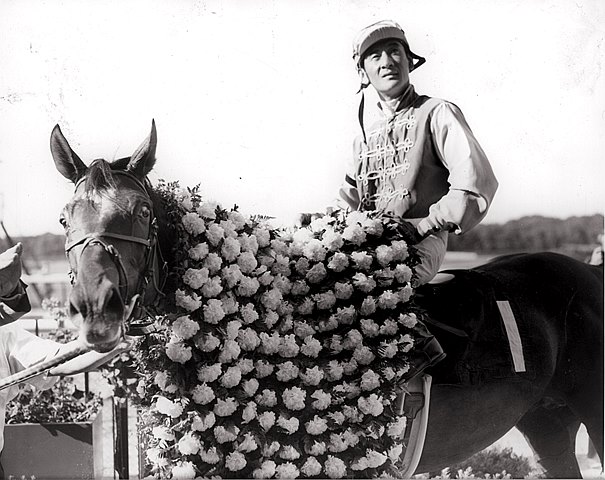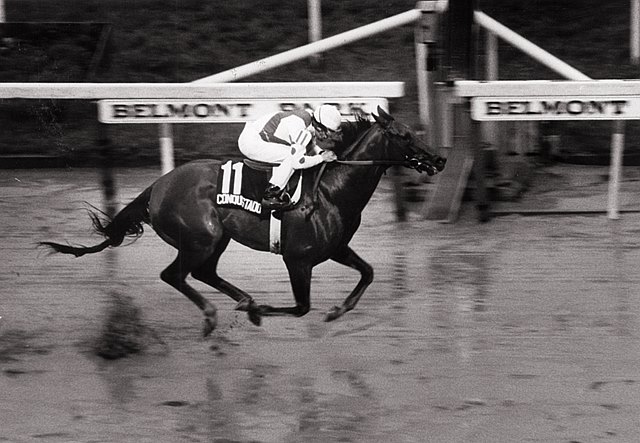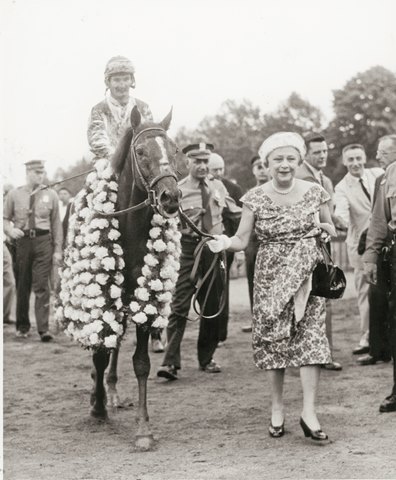The Met Mile and the Belmont Stakes
May 27, 2017
Joseph Di Rienzi
(jdirienzi@ndm.edu)
(jdirienzi@ndm.edu)
The Metropolitan Handicap (gr. I) run at the one mile
distance for many years has been a seminal race for older horses. Run for most
of its history at Belmont Park, it has attracted the best older horses that
trying to demonstrate that they
have the necessary acceleration that would make them attractive stallion
prospects. The list of Met Mile winners features an honor roll that includes
Native Dancer, Gallant Man, Bald Eagle, Kelso, Bold Lad, Buckpasser, and Forego
(twice). However, for a time, the Met’s placement on the schedule between the Preakness Stakes
(gr. I) and the Belmont Stakes (gr. I) enabled it to be used with great success
as a prep for the Belmont Stakes.
What is remarkable about this correlation between the Met
Mile and the Belmont is that at face value there were at least three strong
disconnects. First, is
the variation in distance. The Met Mile is obviously at 8 furlongs; whereas,
the Belmont, the longest American classic, is run at 12 furlongs, a huge
differential in distance. Second, is the rarity of running three year-olds
against the best older horses in late May. Third, is the schedule that had the
Met traditionally run on Memorial Day (May 30) or the Monday it was observed,
and the Belmont contested on the first or second Saturday in June. Thus, there was always less than two weeks
apart, in some years, only five days.
The trainer who used the Met Mile as a prelude to the
Belmont Stakes most successfully was Elliot Burch. Perhaps, he came to this idea of
running a three year-old in the Met Mile from his father, Preston Burch who won the
race in 1950 with Brookmeade Stable’s Greek Ship. In 1959, now as the Brookmeade trainer,
Elliot Burch had Sword Dancer, a bright chestnut son of Sunglow, who had
finished a good third in the climactic Garden State Stakes of 1958. In his
three year-old year, Sword Dancer had registered a series of second place
finishes in major races such as the Florida Derby, the Kentucky Derby (by a
nose to Tomy Lee (GB), and the Preakness Stakes (by four lengths to Royal
Orbit). Burch was on record as
saying, he chose to run his small, but durable colt in the Metropolitan
because, a) he would carrying light weight, and b) his charge needed a
confidence boost. Carrying 114 lb., Sword Dancer scored an authoritative
victory over some of the best Eastern older horses and started a pattern that
Elliot Burch would use successfully with two future Belmont Stakes
winners.
As for the 1959 Belmont Stakes, despite Royal Orbit’s
presence (Tomy Lee did not contest the Preakness or Belmont), the public
settled on the twice classic placed Sword Dancer, ridden by top jockey Bill
Shoemaker, fresh off his Metropolitan win as the favorite. The race was not
without drama and tragedy. Black Hills making a menacing move on the stretch
turn broke down and crashed into fellow Belmont contender, Lake Erie. Somewhat
anticlimactically, Sword Dancer wore down Bagdad in the stretch to win the
Belmont Stakes by 3/4 of a length with Royal Orbit a distant third. With this victory, Sword Dancer, a diminutive bright chestnut with
four white stockings, assumed the leadership of the division with his
hardiness, stamina, and courage. The
rest of 1959 would see “Little Red” expand and extend this dominance, winning
the Monmouth Handicap, the Travers and Woodward Stakes, and, the season ending the Jockey Club Gold Cup.
The next opportunity for Burch came in 1964. Now training
for Paul Mellon’s Rokeby Stable, Burch had Quadrangle, a rangy and leggy bay son
of Cohoes, and produced by the Bull Lea mare Tap Day. Similar to Sword Dancer, Quadrangle had a
productive juvenile year ending with a 10 length victory in the Pimlico
Futurity, promising more to come in his sophomore year. Slow to come to hand as
a three year-old in Florida, Quadrangle won the Wood Memorial in April at
Aqueduct Racetrack, just prior to the Kentucky Derby. Fifth in the Derby and
fourth in the Preakness (both times to Windfields Farm’s dashing Northern Dancer),
Quadrangle appeared to be just below the best of his generation. Elliot Burch
reached again into his trainer
toolkit and decided the Met Mile would be the right instrument to bring out the
best in his colt, and Quadrangle finished a good second, beaten 2 lengths to
six year-old Olden Times.
| Quadrangle (Blood-Horse Library (bloodhorse.com)) |
The Belmont Stakes, run at Aqueduct due to the renovation of Belmont Park, brought together Northern Dancer in his quest for the Triple Crown against classic rivals, Hill Rise, Roman Brother and Quadrangle. The public made the diminutive Canadian, Northern Dancer, the prohibitive favorite to complete the Triple Crown despite qualms about his stamina. This year’s running saw longshot Orientalist set a lugubrious pace with Quadrangle, with blinkers off to relax him and ridden by Manuel Ycaza, racing just off the pace. Hill Rise was third in the early going with Northern Dancer fourth. Quadrangle forged along the inside to the lead with a ½ mile remaining and when Northern Dancer and Roman Brother challenged him in the stretch, he fought them off and was slowly pulling away at the finish, 2 lengths ahead of Roman Brother. Northern Dancer, just held off Hill Rise for third place beaten a total of 6 lengths. Northern Dancer would only race once more, winning his country’s classic the Queen’s Plate before an injury forced his retirement. Quadrangle, had a productive rest of season winning the Dwyer Handicap, the Travers and Lawrence Realization Stakes and finishing third in both the Woodward Stakes and Jockey Club Gold Cup.
Five years later in 1969, Burch trod the same path through
the classics with another Rokeby
runner. A dark coated chestnut,
Arts and Letters, was on the small side, but proportioned perfectly. Virginia
bred by super racehorse and stallion Ribot (GB) out of the Battlefield mare All
Beautiful, his two year-old performances were not as distinguished as Sword
Dancer and Quadrangle, the best being a fourth in the Pimlico-Laurel Futurity.
However, his confirmation and pedigree signaled that he was a horse to watch
for the classics. As a three year-old, like his predecessors, Sword Dancer and
Quadrangle, Arts and Letters was a work in progress winning the Everglades
Stakes at Hialeah, but then finishing second in both the Flamingo Stakes and
Florida Derby. Off a resounding win in the Blue Grass Stakes at Keeneland, Arts
and Letters was one of the more favored horses in the Kentucky Derby. In a
stirring stretch duel, he
finished second to the then undefeated Frank McMahon’s Majestic Prince by a
neck. In the Preakness, the two Derby rivals faced each again, and this time
Arts and Letters missed by a head of catching Majestic Prince who was the
official winner despite what many thought was significant bumping of Arts and
Letters shortly after the start of the race.
 |
| Arts and Letters (Mike Sirco/NYRA (bloodhorse.com)) |
With the showdown with Majestic Prince (whose connections
were somewhat reluctant to race) looming in the Belmont Stakes, Elliot Burch
was eager to have his colt at his sharpest, so he ran him against older horses
in the Metropolitan Handicap. In the field was the leading older horse at the
time, Nodouble who was assigned 129 lb. for the Metropolitan to three year-old
Arts and Letters’ feathery 111 lb. This differential was too much for the older
horse to concede. Arts and Letters, very sharp, won with authority by 2½
lengths with Nodouble second. So once again, Elliot Burch had found the perfect
prep for his Belmont candidate.
The Belmont Stakes drew six entries, but only three were
considered legitimate contenders, Majestic Prince, Arts and Letters and Dike, who
finished a close third in the Derby. They each had their supporters, but the
general public was rooting for Majestic Prince to complete the Triple Crown.
The betting public, however, made Arts and Letters the close second choice. The
running of the race was completely unexpected. Dike who was known for his
closing rallies, went out to set the pace, if you could call it that. The
fractions were glacial, with horses barely getting out of a gallop. Arts and
Letters tracked Dike about 3 lengths back, and Majestic Prince who in his previous races
was always eager to run was well back in fifth. At the ½ mile pole, Arts and
Letters made his challenge inside Dike and easily pulled away. Around the turn,
Braulio Baeza on Arts and Letters was cruising on the lead waiting for the
challenge from Majestic Prince that effectively never came and powered to the
finish 5½ lengths in front. Majestic Prince passed Dike in the stretch for
second (by 2 lengths).
So once again, a Triple Crown was foiled and Majestic Prince’s
unbeaten streak broken at nine. Majestic Prince was returned to California
where efforts to return him to racing where unsuccessful. Arts and Letters
raced the rest of the year, unbeaten,
marching toward the three year-old championship and Horse of the Year with
victories in the Jim Dandy, the Travers, the Woodward and the Jockey Club Gold
Cup.
Once more, in 1982, this Met Mile – Belmont Stakes double
was accomplished with Henyrk de Kwiatkowski’s Conquistador Cielo, a racy bay
son of Mr. Prospector out of a Bold Commander mare. As a two year-old, he had a brief campaign
that saw him win the Saratoga Special (gr. II) and, after suffering an injury in
finishing a close fourth in the Sanford Stakes (gr. II), was retired for the
year. Trained by Woody Stephens, in his first start as a three year-old, he finished third in a 7
furlong allowance race at Hialeah. Then, he was an impressive winner of a similar
race 10 days later showing high speed. Delayed by a minor injury, Conquistador
Cielo ran in what had previously been called the Preakness Prep a week prior to
Pimlico’s signature race and came from just off the pace to win by 3 lengths in
the 8½ furlong contest. Withheld from the Preakness Stakes (gr. I), Stephens
shipped his colt back to Belmont Park where he ran a 1 mile allowance race for
three years and older and
stunned the field with an 11 length win in very fast time.
 |
| Conquistador Cielo (Milt Toby (bloodhorse.com)) |
Stephens realizing what he had in his barn, entered
Conquistador Cielo less than two weeks later in the Metropolitan Handicap (gr.
I) facing older horses, but only assigned 111 lb. in the fourteen horse field.
The New York racegoers saw his form and despite his lack of seasoning made
Conquistador Cielo the post time favorite. Under regular jockey Eddie Maple,
the son of Mr. Prospector put on a show, racing with the early pace and
swooping clear to a
7¼ length victory over Silver Buck with fellow sophomore Star Gallant another
2½ length back in third place. The time for the mile was a new track record,
faster than Bald Eagle, Kelso, Bold Lad, Buckpasser and Forego ever ran in
their respective Met Mile victories. The buzz in the winner’s circle was the
idea of entering Conquistador Cielo in the Belmont Stakes (gr. I) even though
it was only five days away. After some thought, owner de Kwiatkowski, an
expansive and enterprising personality, gave the go ahead, and Woody Stephens,
taking a page from Elliot Burch’s playbook, recognized a Met Mile – Belmont
double was not without precedent.
Eleven horses entered the Belmont and, although there was
not a Triple Crown possibility, the race had all the prime contenders in the
Kentucky Derby (gr. I) winner, Gato Del Sol, Preakness Stakes winner, Aloma’s
Ruler, unlucky Preakness loser, Linkage, and the unknown factor, Conquistador
Cielo. The handsome colt’s Met Mile win was off the charts, but the prevailing
question was he too “speedy” with Mr. Prospector and Bold Ruler (through his
dam’s sire) in his bloodlines to handle the 1½ mile distance. A pace duel with,
perhaps, Aloma’s Ruler, seemed likely compromising both their chances. Adding
to the drama, Eddie Maple, Conquistador Cielo’s rider was injured in a fall at
Belmont the day before the Belmont and could not ride. Woody Stephens made a
phone call late in the day to California to secure the services of Laffit
Pincay, Jr., who had ridden for him in the past. Pincay, after some travel
complications managed to get to Belmont Park (via Boston) on the morning of the
race to ride a horse he had never seen.
The public settled on Linkage as the favorite, although
there were also questions about his stamina. Conquistador Cielo was the second
choice and Gato Del Sol the third favorite. A sloppy racetrack on Belmont Day
may have played to Cielo’s favor, although he had no previous off track
experience. As the field left the starting gate, Aloma’s Ruler tried to gain
the lead, but he was outsprinted, first by longshot Anemal to his inside, then
Conquistador Cielo racing very wide around the clubhouse turn. Once the leaders
straightened out on the backstretch, Conquistador Cielo gained the lead and set
credible fractions. His first challenge came from High Ascent who ranged up on
the inside. That was easily repelled and, as Cielo extended his lead around the
sweeping far turn, Linkage became his closest pursuer. However, the chase was
futile, for just as in the Met Mile, Conquistador Cielo was soaring as the
name, “Conqueror of the Sky”, implies. He easily pulled away to an astounding
margin, that, if visions of Secretariat’s Belmont win in 1973 had faded from
memory, this would have been the most dominant Belmont win in recent history.
Some 14 lengths behind the flying “Conquistador” was Gato Del Sol who rallied
to be second, 4 lengths ahead of Illuminate who had 3¾ lengths ahead of
Linkage. Owner de Kwiatkowski and
trainer Stephens were justly rewarded by their courage in running back so
quickly, but we have already seen there was precedent. In the time space of
three weeks, Conquistador Cielo had gone from a promising three year-old to the
leader of his division to a likely Horse of the Year candidate. He would go on
to win the Dwyer (gr. II) and the Jim Dandy (gr. II) Stakes before being
retired after finishing third in the Travers Stakes.
The only other three year-old in modern times (since the
last quarter of the twentieth century to the present) to have raced in the
Metropolitan Handicap and to have run in the Belmont Stakes was Gulch. Owned by Peter Brant and
then trained by LeRoy Jolley, this racy bay son of Mr. Prospector out of the
sturdy racemare Jameela was a top two year-old and carried his form into his
three year-old season winning the Wood Memorial (gr. I), but was unplaced in
both the Derby (sixth) and the Preakness (fourth). Gulch did not win the
Belmont, but improved his classic placing to finish third, although he was
beaten 14 lengths by the runaway winner, Bet Twice. (Gulch did finish a neck
ahead of dual classic winner Alysheba). Gulch would return the following year to
win the Met Mile as a four year-old and with a victory in the Breeders’ Cup
Sprint (gr. I) be voted Eclipse Award Sprinter of 1988. This versatile horse
would complete the Met Mile – Belmont double in an unorthodox way by siring Thunder
Gulch who would win the Belmont Stakes (and the Kentucky Derby) in 1995.
There have been other three year-olds in the last
half-century that have won the Metropolitan Mile, Dixie Brass (1992), Holy Bull
(1994), and Honor and Glory (1996), but none of these competed in the Belmont
Stakes. The feat of winning both races in the same year which has been rare, is
currently impossible, in that the New York Racing Association since 2014 cards
the Metropolitan Handicap on the same day as the Belmont, trying to package an
intense day of racing for the not-so racing centric public. (A footnote, that
in the two few years, the Belmont winner of the previous year has in the case
of Dogwood Stable’s Palace Malice (Belmont winner in 2013) won the Met Mile in
2014, and in the case of Robert S. Evans’ Tonalist (Belmont winner in 2014) finished
second in the 2015 edition of the Met.)
Even without the concurrence of these two races, it is
highly unlikely that any trainer (or owner) in the United States would attempt
to race their three year-old in both. We are living in an age of thoroughbred racing
where less racing, with more intervals between starts, is the norm and most
conditioners are reluctant to risk their horses in situations they might fail
miserably. In fact, most trainers think the three weeks between the Belmont and
Preakness is too short, not to mention the two week Derby and Preakness
interval. But as this essay tries to demonstrate, enterprising trainers, aware
of their horse’s condition can achieve great things if they are willing to try.
“The readiness is all.” (W. Shakespeare,
Hamlet, Act V, Scene ii.)

No comments:
Post a Comment